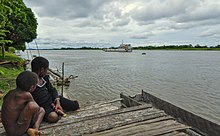This article needs to be updated. (July 2018) |

In 2009, Papua New Guinea was a source, destination, and transit country for men, women, and children subjected to trafficking in persons, specifically forced prostitution and forced labor. Women and children were subjected to commercial sexual exploitation and involuntary domestic servitude; trafficked men were forced to provide labor in logging and mining camps. Children, especially young girls from tribal areas, were most vulnerable to being pushed into commercial sexual exploitation or forced labor by members of their immediate family or tribe. Families traditionally sold girls into forced marriages to settle their debts, leaving them vulnerable to involuntary domestic servitude, and tribal leaders trade the exploitative labor and service of girls and women for guns and political advantage. Young girls sold into marriage were often forced into domestic servitude for the husband's extended family. In more urban areas, some children from poorer families were prostituted by their parents or sold to brothels. Migrant women and teenage girls from Malaysia, Thailand, China, and the Philippines were subjected to forced prostitution, and men from China were transported to the country for forced labor.[1]
In 2009, Asian crime rings, foreign logging companies, and foreign businessmen arranged for some women to voluntarily enter Papua New Guinea with fraudulently issued tourist or business visas. Subsequent to their arrival, the smugglers turned many of the women over to traffickers who transport them to logging and mining camps, fisheries, and entertainment sites where they are exploited in forced prostitution and involuntary domestic servitude. Foreign and local men are exploited for labor at mines and logging camps, where some receive almost no pay and are compelled to continue working for the company indefinitely through debt bondage schemes. Employers fostered workers’ greater indebtedness to the company by paying the workers sub-standard wages while charging them artificially inflated prices at the company store; the employees’ only option becomes to buy food and other necessities on credit. Government officials facilitated trafficking by accepting bribes to allow illegal immigrants to enter the country or to ignore victims forced into prostitution or labor, by receiving female trafficking victims in return for political favors, and by providing female victims in return for votes.[1]
In 2009, the Government of Papua New Guinea did not fully comply with the minimum standards for the elimination of trafficking, and is not making significant efforts to do so. Despite the establishment of an interagency anti-trafficking committee, initial efforts to address forced child labor, and new programs to educate the public about trafficking, the government did not investigate any suspected trafficking offenses, prosecute or convict any trafficking offenders under the existing law of Papua New Guinea, or address allegations of officials complicit in human trafficking crimes.[1]
The U.S. State Department's Office to Monitor and Combat Trafficking in Persons placed the country in "Tier 2 Watchlist" in 2017.[2] By 2023, it was moved to Tier 3.[3]
- ^ a b c "Trafficking in Persons Report 2010 Country Narratives - Countries N Through Z". US Department of State. 2010-06-17. Archived from the original on 2010-06-17. Retrieved 2023-02-17.
 This article incorporates text from this source, which is in the public domain.
This article incorporates text from this source, which is in the public domain.
- ^ "Trafficking in Persons Report 2017: Tier Placements". www.state.gov. Archived from the original on 2017-06-28. Retrieved 2017-12-01.
- ^ US Government website, Trafficking in Persons Report 2023
